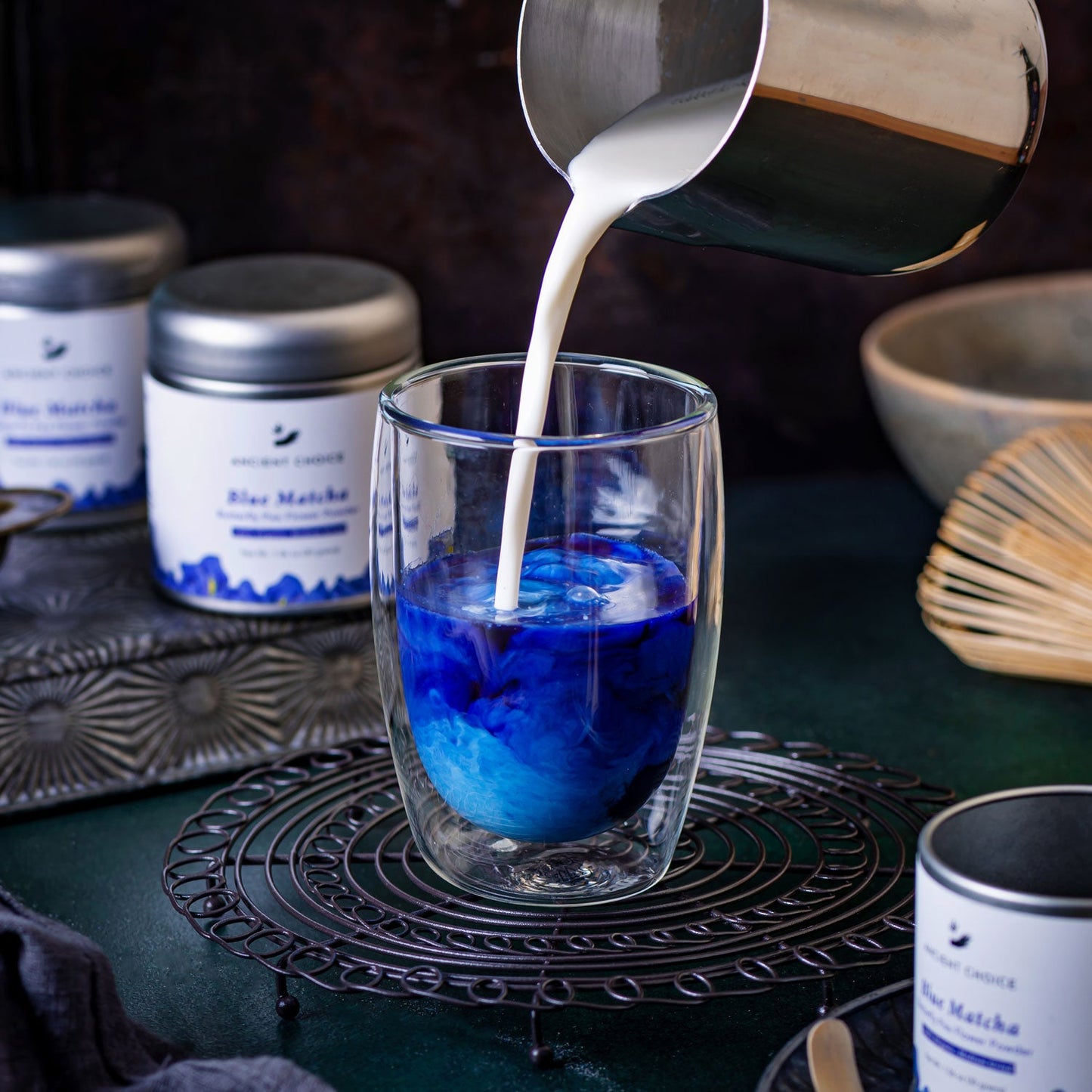
What is Blue Matcha?
Blue Matcha is a premium blue tea powder made by grinding the dried flowers of the Butterfly Pea (Clitoria ternatea) plant into a fine powder. This powder is usually then mixed with hot water or milk to create a variety of vibrant, blue-colored drinks.

Unlike traditional green matcha, blue matcha is caffeine-free, making it a great option for those looking to reduce their caffeine intake. While blue matcha has traditional uses in Ayurvedic and Chinese medicine, it has become increasingly popular in the West as a healthy, colorful alternative to traditional matcha. The unique color-changing properties of blue matcha drinks, which can change from blue to purple with the addition of lemon or lime, make them a fun and visually stunning beverage to enjoy in addition to their nutritional benefits.
The powder can be used as an ingredient in a variety of recipes, including baked goods, smoothies, and cocktails, and its distinctive color can add an eye-catching touch to any dish. The process of preparing and enjoying blue matcha is a meditative and calming experience, which is why it has been used in traditional ceremonies throughout Southeast Asia. Despite its origins, blue matcha has become a popular beverage around the world and can be found in cafes and restaurants, as well as in many homes.
Blue Matcha Origins
Butterfly pea flower tea, the origin of blue matcha, has a rich cultural history in Southeast Asia. The tea has been consumed for centuries in countries such as Thailand, Vietnam, and Malaysia, and is often served as a refreshing drink during hot weather.
In Thailand, butterfly pea flower tea is known as "nam dok anchan" and is sometimes sweetened with honey and served with a squeeze of lime juice to enhance the flavor and color. The tea is also used as a natural dye for food, giving dishes a vibrant blue color.
In traditional medicine practices in Thailand and Vietnam, butterfly pea flower has been used for a variety of medicinal purposes, including improving memory, reducing stress, and treating eye conditions. In Ayurvedic medicine, the butterfly pea flower is treasured for its calming effect on the mind and is used to promote relaxation and reduce anxiety. The cultural significance of butterfly pea flower and blue matcha extends beyond their health benefits and into the realm of culinary art and cultural traditions.
How Are Blue Matcha Flowers Grown?
Butterfly pea flowers are typically found growing in tropical climates, including Southeast Asia and South America. The butterfly pea plant is a climbing vine that can grow up to 5 meters long and produces vivid blue flowers that are about 4-5 centimeters in diameter. The flowers bloom throughout the year and are harvested when they are fully mature, which typically takes around 3-4 months.

To harvest the flowers farmers or foragers typically pick them by hand in the early morning before the heat of the day sets in. This helps to ensure that the flowers are at their freshest and have not been wilted by the sun.
After harvesting, the flowers can be used fresh or dried for later use. The dried flowers can be stored for several months in a cool, dry place. Traditionally, the flowers are sun-dried, which better preserves the nutritional compounds as compared to other high-heat drying methods.
The cultivation of butterfly pea flowers is generally considered to be environmentally sustainable, as the plant is hardy and requires little in the way of fertilizers or pesticides. Additionally, the flowers are often used to support pollinators such as bees and butterflies, which can have positive effects on local ecosystems.
Consumption vs. Extraction
Traditional steeped teas use hot water to extract flavor and nutrients out of plant matter. While this will yield delicious and healthy drinks, the extraction method is never 100% efficient. It is inevitable that some compounds will be left behind in the process and discarded along with the “spent” tea.
Similar to green matcha, the butterfly pea flowers in blue matcha tea are fully consumed, allowing for a higher intake of antioxidants and other beneficial compounds present in the flower. When properly ground into a fine powder, the butterfly pea tea powder is suspended in the drink and consumed with every sip.

How to Make Blue Matcha
Blue matcha tea powder is typically consumed as either a blue matcha latte or a color-changing iced tea.
To prepare blue matcha, you'll need a few pieces of equipment:
- Teakettle or pot: You'll need a way to boil water. A tea kettle or pot works well.
- Heat-proof bowl: You'll need a heat-proof bowl to brew the tea in. A traditional matcha bowl is ideal, but any heat-proof bowl will work.
- Whisk: To froth the tea, you'll need a whisk. A traditional bamboo matcha whisk (chasen) is recommended, but you can use an electric frother or a small whisk as well.
- Strainer (optional): If you want to remove any bits of flower or other impurities from the tea, you can use a strainer. A fine-mesh strainer or tea strainer works well.
- Serving bowl or cup: You'll need a bowl or cup to serve the tea in. A traditional matcha bowl or teacup is ideal, but any cup or mug will work.
Once you have your blue matcha ready, try adding steamed milk and honey for a delicious blue matcha latte.
Health Benefits of Blue Matcha
Blue matcha is probably most famous in western culture for its magical, color changing properties. That color is more than a visually stunning party trick though - the phytochemicals that give blue matcha its vibrant blue color are also linked to a wealth of interesting research.
Most notably, blue matcha has been studied for its anthocyanin content, which are the same type of antioxidants that put the blue color in blueberries. Antioxidants are compounds that protect cells from oxidative stress, which has been linked to numerous chronic diseases, including cancer, heart disease, and diabetes.
Blue matcha may also contain significant amounts of flavonoids, which are a type of antioxidant that has been shown to have anti-inflammatory and anti-cancer properties. One specific flavonoid found in the butterfly pea flower is quercetin, which has been studied for its potential to lower blood pressure and reduce inflammation.
While more research is needed to fully understand its potential health benefits, the consumption of butterfly pea flower in blue matcha and other recipes is a promising area of study in the field of natural wellness.
Blue Matcha Recap
In conclusion, blue matcha is a unique and flavorful alternative to traditional green tea. Its vibrant blue color adds a fun and exotic element to any beverage, and its potential health benefits make it a worthwhile addition to any diet.
When making blue matcha, it is important to use high-quality butterfly pea flower petals for optimal flavor and nutrient content. They should be sun-dried, ideally wild foraged, and certified Non-GMO.
While there are no known risks associated with consuming blue matcha, it is always important to consult with a healthcare professional before making any major changes to your diet. Overall, if you are looking for a refreshing and healthy beverage option that is also Instagram-worthy, give blue matcha a try!
Blue Matcha Recipes
Now that you have a good idea about what blue matcha is, here are a few ideas for how to include it as an ingredient in your own kitchen.
Blue Matcha Latte
Making a blue matcha latte is not much different from making a traditional matcha latte. The fundamentals are the same - you'll need to start with your blue matcha tea base and then add steamed milk. For a easy, step-by-step guide, check out our Blue Matcha Latte Recipe.
Blue Matcha Cocktail
Another popular use for blue matcha is in cocktails, where the color-changing ability of the flower is used to make exciting drinks.


